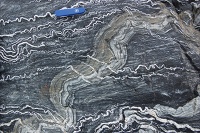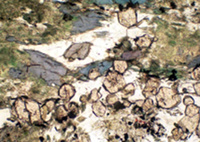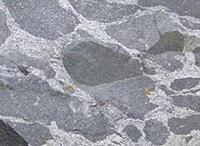Research at the Institute of Petrology and Structural Geology is realized by three research groups
Lithospheric Deformation Research Group
Research group leader: Ondrej Lexa
Members: Petr Jeřábek, Martin Racek, František Hrouda, Klára Jůzlová
 Lithospheric deformation research group study processes of rock deformation from micro- up to lithospheric scale. Field structural geology is combined with metamorphic and magmatic petrology in order to describe and understand tectonic processes in space and time. Our research is also focused on microstructural studies, which are an important tool for deciphering rock rheology and melt segregation processes. More specifically, main research topics of the group are: (1) structural studies in orogenic belts, (2) crust and mantle interactions and large-scale tectonic processes, (3) microstructures, textures, deformation mechanisms and rheology of deformed rocks, (4) deformation of melt-bearing rocks and high temperature material flow, (5) magma emplacement, magma flow, and particle behaviour in viscous fluids.
Lithospheric deformation research group study processes of rock deformation from micro- up to lithospheric scale. Field structural geology is combined with metamorphic and magmatic petrology in order to describe and understand tectonic processes in space and time. Our research is also focused on microstructural studies, which are an important tool for deciphering rock rheology and melt segregation processes. More specifically, main research topics of the group are: (1) structural studies in orogenic belts, (2) crust and mantle interactions and large-scale tectonic processes, (3) microstructures, textures, deformation mechanisms and rheology of deformed rocks, (4) deformation of melt-bearing rocks and high temperature material flow, (5) magma emplacement, magma flow, and particle behaviour in viscous fluids.
Metamorphic Petrology Research Group
Research group leader: Wali Shah Faryad
Members: Martin Racek, Jan Kulhánek, Ondrej Lexa, Tereza Zelinková
 Metamorphic petrology is an important tool for deciphering tectonic history of orogenic belts. Members of our research group are specialized in phase petrology and use equilibrium thermodynamics for modelling of metamorphic pressure and temperature conditions (software PERPLE_X, THERMOCALC). Besides derivation of metamorphic conditions, our research group is focused on studies of microstructures in order to evaluate reaction history of metamorphic rocks. Our current research involves metamorphic studies in terrains of various geodynamic settings: (1) Bohemian massif (high grade rocks as eclogites, granulites and migmatites of the Moldanubian zone, Barrovian metamorphism in reactivated continental basement of the Moravo-Silesian zone, subduction-related metamorphism of the Saxothuringian zone). (2) Eastern part of Western Carpathians (Gemer, Vepor, Zemplin units) and the Meliata accretionary complex. (3) Eastern Alps, Western Hindukush (Afghanistan) and Himalayas (Main Central thrust, Higher Himalaya crystalline), Madagascar and the Kaoko belt in NW Namibia.
Metamorphic petrology is an important tool for deciphering tectonic history of orogenic belts. Members of our research group are specialized in phase petrology and use equilibrium thermodynamics for modelling of metamorphic pressure and temperature conditions (software PERPLE_X, THERMOCALC). Besides derivation of metamorphic conditions, our research group is focused on studies of microstructures in order to evaluate reaction history of metamorphic rocks. Our current research involves metamorphic studies in terrains of various geodynamic settings: (1) Bohemian massif (high grade rocks as eclogites, granulites and migmatites of the Moldanubian zone, Barrovian metamorphism in reactivated continental basement of the Moravo-Silesian zone, subduction-related metamorphism of the Saxothuringian zone). (2) Eastern part of Western Carpathians (Gemer, Vepor, Zemplin units) and the Meliata accretionary complex. (3) Eastern Alps, Western Hindukush (Afghanistan) and Himalayas (Main Central thrust, Higher Himalaya crystalline), Madagascar and the Kaoko belt in NW Namibia.
Magmatic Research Team
Research group leader: Václav Špillar
Members: Vojtěch Janoušek, Kryštof Verner
 We are a group of young geoscientists (including some young souls trapped in aging body) using the field-, experiment- and modeling-based approaches to investigate the magma evolution from its source in the Earth’s crust or mantle to its final intrusion or eruption. Our research interests cover variable aspects of igneous petrogenesis ranging from magma generation, through transport, differentiation and emplacement to its final solidification as well as the study of the pre- and syn-eruptive conditions and processes of active volcanoes. We employ broad scale of methods from fieldwork and conventional petrography through major- and trace-element and isotope geochemistry, numerical modelling and laboratory experiments.
We are a group of young geoscientists (including some young souls trapped in aging body) using the field-, experiment- and modeling-based approaches to investigate the magma evolution from its source in the Earth’s crust or mantle to its final intrusion or eruption. Our research interests cover variable aspects of igneous petrogenesis ranging from magma generation, through transport, differentiation and emplacement to its final solidification as well as the study of the pre- and syn-eruptive conditions and processes of active volcanoes. We employ broad scale of methods from fieldwork and conventional petrography through major- and trace-element and isotope geochemistry, numerical modelling and laboratory experiments.





















